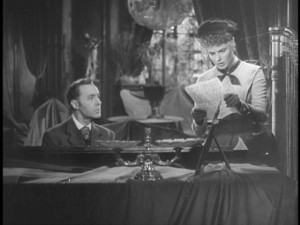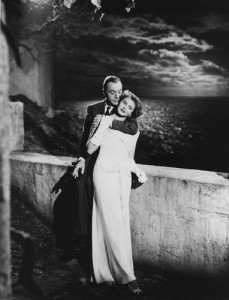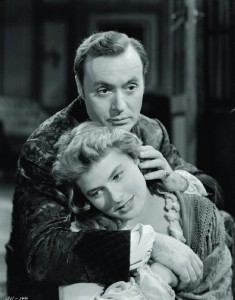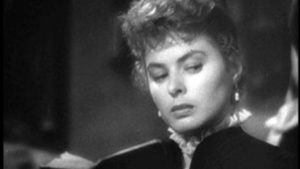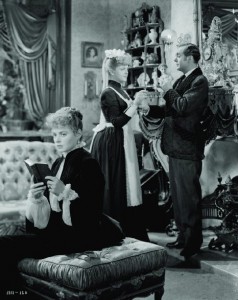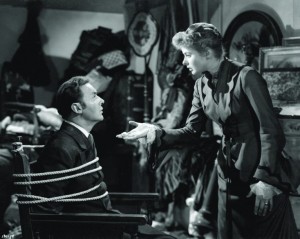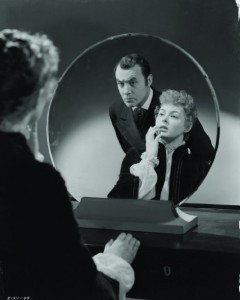Gaslight ***** (1944, Ingrid Bergman, Charles Boyer, Joseph Cotten, Angela Lansbury, Dame May Whitty) – Classic Movie Review 1231
Gaslight (1944) won two Academy Awards. The Oscar voters surprisingly preferred Ingrid Bergman over the favourite Barbara Stanwyck (in Double Indemnity) for her performance as the naïve socialite wife driven to distraction (by Charles Boyer)
Director George Cukor’s polished and stylish 1944 Hollywood remake of the famous 1940 British paranoia thriller Gaslight in some respects is only equally good, but it greatly benefits from a much better, much costlier production. Though still set in the Victorian age, around 1874, Cukor’s film brings the 1938 Patrick Hamilton stage chiller Gas Light gleamingly and chillingly up to date and the larger scale and budget gives it a smarter feel, with intricate Victorian sets and beautiful period decorations.
It won two Academy Awards. At Oscar time, the Academy voters surprisingly preferred Ingrid Bergman over the favourite Barbara Stanwyck (as the treacherous Phyllis Dietrichson in Double Indemnity) for her performance as Paula Alquist Anton, the naïve socialite wife (of Gregory Anton – played by Charles Boyer) driven to distraction.
Stanwyck was magnificently graceful and generous in defeat, saying she was ‘a member of the Ingrid Bergman Fan Club’ and didn’t ‘feel at all bad about the award because my favorite actress won it and has earned it by all her performances’. It is noticeable, however, that she does not say ‘she has earned it by this performance.’ Stanwyck ended up with four Oscar nominations and no wins, while Bergman won again for Anastasia (1956) and Murder on the Orient Express (1974).
Quibbles over Bergman’s Oscar win apart, this is a supremely stylish, gripping psychological thriller, with the lavish Victorian period re-creation the Brits could not afford in 1938, with the art direction winning a second Oscar. It is propelled by the sleekest possible direction by Cukor, who brings out the best in all his actors.
This included a story-telling method to get Bergman in the right mindset as filming progressed, with Cukor narrating the film’s entire plot to Bergman up to the point of the scenes they were set to film each day, as the film was not shot in sequence and Bergman’s character was changing over time.
Contractually top billed Boyer is exceptionally creepy as the charming but ice-cold killer who weds his victim’s niece (Bergman) then tries to drive her out of her mind for the inheritance of a hoard of gems. Bergman responds by being luminously vulnerable.
Joseph Cotten gives a dashing and romantic turn as the stubborn investigating Scotland Yard detective Brian Cameron, while Angela Lansbury (Oscar-nominated in her debut at 18) as the lovestruck maid Nancy Oliver and Dame May Whitty as the nosey spinster neighbour Miss Bessie Thwaites complete the delicious main acting package.
Also in the cast are Barbara Everest, Terry Moore, Eustace Wyatt, Emil Rameau, Edmund Breon, Tom Stevenson, Halliwell Hobbes, Heather Thatcher, Lawrence Grossmith, Arthur Blake, Lillian Bronson, Leonard Carey, Helen Flint, Gibson Gowland, Bobby Hale, Joy Harrington, Charles McNaughton, Syd Saylor and Eric Wilton.
This is Hollywood golden years professionalism at its finest. The public loved it and it was well reviewed. A good-sized hit, Gaslight earned just over $4,500,000 and made nearly $1 million profit.
It is very much in the vein of Alfred Hitchcock’s The Lodger, made way back in 1927, remade as The Lodger in 1932, with a second remake as The Lodger in this same year as Gaslight, 1944. Hamilton also wrote the play Rope (1929), the basis of Hitchcock’s 1948 film Rope. Bergman and Cotten re-teamed for Hitchcock’s similarly themed Under Capricorn in 1949. Gaslight would have been the perfect project for Hitchcock, even starring his favourite actress, Bergman, and May Whitty from The Lady Vanishes.
At the 1945 Academy Awards, the film was nominated for seven Oscars: Best Picture, Best Actress for Ingrid Bergman, Best Actor for Charles Boyer, Best Supporting Actress for Angela Lansbury, Best Adapted Screenplay (John L Balderston, Walter Reisch, John Van Druten), Best Art Direction-Interior Decoration, Black-and-White (Cedric Gibbons, William Ferrari, Edwin B Willis, Paul Huldschinsky) and Best Cinematography, Black-and-White (Joseph Ruttenberg).
Only Bergman and the art direction/ set decoration won. The gasoliers are real and the one in Boyer’s bedroom comes from Senator Milton Latham’s 1872 Menlo Park, California, mansion, which was torn down in 1942.
To avoid confusion with the first film, this version was in the UK originally given the title The Murder in Thornton Square. When MGM bought the remake rights to Gaslight, they insisted on a clause that all existing prints of the first film would be destroyed, and the studio even tried to destroy all the negatives. Fortunately, this was unsuccessful, though the film was rarely seen for the next few decades.
It is thought that original Gaslight film director Thorold Dickinson surreptitiously struck off a print himself before the negatives were binned. Some prints of the original Gaslight survive because they were mistakenly labelled Angel Street, the name of the US stage production.
Patrick Hamilton’s original play Gas Light premiered in London at the Apollo Theatre in December 1938 and ran for six months. Hamilton’s play was originally staged on Broadway with the title changed to Angel Street at the John Golden Theater on 5 December 1941, running for 1295 performances with a cast including Leo G Carroll, Vincent Price (in his first role as a villain) and Judith Evelyn, becoming the longest-running melodrama in Broadway history. It remains one of the longest-running non-musicals in Broadway history and a perennial favourite with repertory and amateur theatre companies.
New scenes are added to the play and most of the characters’ names are changed. Cotten’s character is changed from a stout, elderly man to a young, handsome one as a potential love interest for Bergman.
Lansbury was only 17 when filming began and as a minor had to be monitored by a social worker. When Lansbury went on set on her 18th birthday, she found that Bergman and the crew had organised a party for her, and a scene in which she lights a cigarette could finally be shot immediately after.
Lansbury had never acted before her screen test, but she impressed Cukor with her natural talent and professionalism. When she told her boss at Bullocks Department Store in Los Angeles that she was leaving, he offered to match the pay at her new job. She told him she would be earning $500 a week instead of $27.
Columbia Pictures bought Gaslight as a vehicle for Irene Dunne and Charles Boyer, but sold the rights to the MGM studio, which wanted to star Hedy Lamarr, who turned down playing the role of Paula, though she eventually played in the similar Experiment Perilous (also 1944). The strong and independent Bergman was also at first reluctant to play Paula, thinking she would be unable to play the timid and fragile character convincingly.
Bergman named Boyer the most intelligent actor she worked with and one of the nicest: ‘He was widely read and well educated, and so different’.
2014 is the 70th anniversary of Lansbury’s debut in the movies, celebrated by appearing on stage in London’s West End as the dotty medium Madame Arcati in a hit revival of Noel Coward’s Blithe Spirit.
Dame Angela Brigid Lansbury DBE died in her sleep at her home in Los Angeles on 11 October 2022, aged 96.
Gaslight is immortalised after inspiring the term gaslighting as a form of psychological abuse in which false information is presented to the victim with the intent of making them doubt their own memory and perception.
Terry Moore was born Helen Luella Koford on 7 January 1929 in Los Angeles. She was nominated for the Academy Award for Best Supporting Actress for Come Back, Little Sheba (1952). Terry Moore (who plays, uncredited, Ingrid Bergman’s character Paula Alquist at the age 14) is the last surviving cast member of Gaslight.
http://derekwinnert.com/rope-classic-film-review-428/
http://derekwinnert.com/the-lodger-a-story-of-the-london-fog-classic-film-review-274/
http://derekwinnert.com/under-capricorn-classic-film-review-452/
© Derek Winnert 2014 Classic Movie Review 1231
Link to Derek Winnert’s home page for more film reviews: http://derekwinnert.com/


